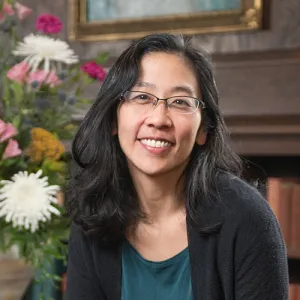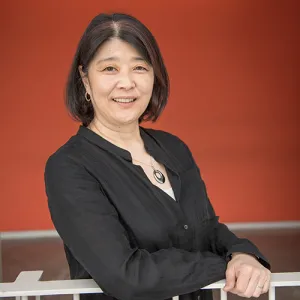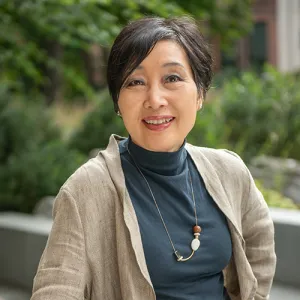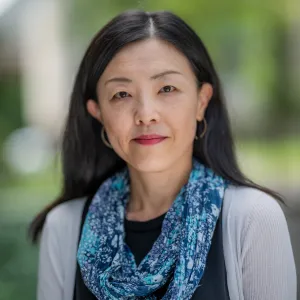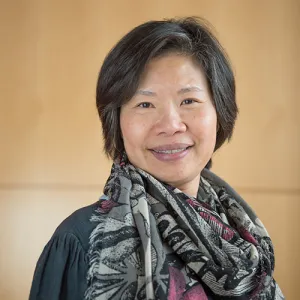
East Asian Languages & Cultures
The Department of East Asian Languages and Cultures offers multiple pathways for students to develop their knowledge of the vibrant cultures of China, Japan, and Korea. While developing linguistic and cultural fluency through our language, literature and culture courses, students will engage with a diverse array of genres from traditional poetry to popular fiction and will explore issues such as translation, identity and gender within traditional and modern contexts. Students can choose to further expand their knowledge of East Asia through courses in anthropology, art history, economics, government, history, music, religion and world literatures.
Within the major, students can choose tracks in either Chinese, Japanese, or East Asian studies and take a combination of language, literature, culture or other classes in the humanities and social sciences. The minor allows for concentrations in Chinese, Japanese, Korean, or East Asian studies. We also encourage students to take advantage of our outstanding study abroad programs, where they accelerate their language studies and learn firsthand about contemporary Chinese, Japanese, or Korean society and culture.
Requirements & Courses
Goals for Majors in East Asian Languages and Cultures
To develop linguistic and cultural fluency, students will:
- Explore and analyze texts, arguments, and social phenomena relating to East Asia.
- Integrate general and specialized knowledge with appropriate disciplinary frameworks to ask productive questions and solve problems in their study of China, Japan or Korea.
- Design and carry out an independent, thesis-driven research project (the seminar).
- Develop an understanding of East Asian language, literature and culture—modern and premodern—that will give them historical and comparative perspectives on the world that go beyond simple East-West binaries.
- Engage with the international community at Smith and abroad, learning to communicate respect and understanding across cultures, preparing for—and beginning—lives of ongoing influence in today’s global world.
- Majors and minors in the Chinese, Japanese and Korean tracks will learn to use Chinese, Japanese or Korean to navigate a variety of social and professional situations appropriately and confidently, and to have nuanced discussions about social and cultural issues, as well as professional and academic topics that are of interest to them. They will gain a deep understanding of and fluency in one language and culture.
- Majors and minors in the East Asian studies track will achieve at least intermediate proficiency in Chinese, Japanese or Korean, including listening, speaking, reading and writing. They will develop a multidimensional, interdisciplinary understanding of the arts, beliefs, societies and traditions of either one East Asian country or of a specific theme across East Asia as a region.
East Asian Languages and Cultures Major
Chinese Track
The first year of Chinese (CHI 110 and CHI 111, or CHI 120 and CHI 121) is a prerequisite for admission to the major.
Requirements
Eleven courses (46 credits)
- Second-year language courses (10 credits): CHI 220 and CHI 221 (two courses). Students who place into the third year or above will have this credit requirement waived (that is, such students need only nine courses or 36 credits for the major).
- Third-year language courses (8 credits): CHI 301 and CHI 302 (two courses). In consultation with their adviser, a student whose proficiency places them beyond the third year must substitute advanced language or literature courses for this requirement.
- At least three EAL-prefix courses (12 credits) in Chinese literature or culture, including a departmental seminar. Students concentrating on China are strongly encouraged to take EAL 231, EAL 232/ WLT 232, and/or EAL 234 early, and they must take at least one of these three courses.
- At least one EAL-prefix course (4 credits) focusing principally on the literature of another East Asian country.
- Three additional courses (12 credits), which may be chosen from other advanced language or literature courses in the department or, at the recommendation of the adviser, from related courses in other departments.
- No more than five of the 11 required courses shall normally be taken in other institutions, such as through the Five Colleges, study abroad programs or summer programs. Students should consult their advisers prior to taking such courses.
- S/U grading option is not allowed for courses counting toward the major.
- Students with native fluency of a language are encouraged to take another East Asian language.
Japanese Track
The first year of Japanese (JPN 110 and JPN 111) is a prerequisite for admission to the major.
Requirements
Eleven courses (46 credits)
- Second-year language courses (10 credits): JPN 220 and JPN 221 (two courses). Students who place into the third year or above will have this credit requirement waived (that is, such students need only nine courses or 36 credits for the major).
- Third-year language courses (8 credits): JPN 301 and JPN 302 (two courses). In consultation with their adviser, a student whose proficiency places them beyond the third year must substitute advanced language or literature courses for this requirement.
- At least three EAL-prefix courses (12 credits) in Japanese literature or culture, including a departmental seminar. Students concentrating on Japan are strongly encouraged to take both EAL 241 and EAL 242, but they must take at least one of the two.
- At least one EAL-prefix course (4 credits) focusing principally on the literature of another East Asian country.
- Three additional courses (12 credits), which may be chosen from other advanced language or literature courses in the department or, at the recommendation of the adviser, from related courses in other departments.
- No more than five of the 11 required courses shall normally be taken in other institutions, such as through the Five Colleges, study abroad programs or summer programs. Students should consult their advisers prior to taking such courses.
- S/U grading options are not allowed for courses counting toward the major.
- Students with native fluency of a language are encouraged to take another East Asian language.
East Asian Studies Track
The major track in East Asian studies reflects the emergence of East Asia politically, economically and culturally onto the world scene, especially during the last century, and anticipates the continued importance of the region in the future. It also offers students an opportunity to develop a coherent and comprehensive understanding of the great civilizations of the Asia Pacific region.
The major track in East Asian studies combines language study with courses in anthropology, art, economics, government, history and religion. Majors graduate from the program with a firm grasp on the culture and history of the region, as well as a command of at least one language. Thus, the program prepares students for post-graduate endeavors ranging from graduate school to careers in the public and private sectors dealing with East Asia.
Requirements
Ten courses
- Two East Asian language courses: The second year of an East Asian language, which can be fulfilled by CHI 220 and CHI 221, JPN 220 and JPN 221, or KOR 201 and KOR 202, or any higher-level courses. Extensive language study is encouraged, but only two courses at the second-year level or higher will count toward the major. Normally, language courses will be taken at Smith or within the Five Colleges. Students with native or near-native fluency in an East Asian language must take a second East Asian language. Native and near-native fluency is defined as competence in the language above the fourth-year level.
- Two survey courses
- One survey course on the premodern civilization of an East Asian country: HST 222pp, HST 223at, EAL 231, EAL 233, EAL 234, EAL 235, EAL 241, ARH 290ce, or ARH 352ce
- HST 120, normally taken by the second year
- Six elective courses, which shall normally be determined in consultation with the adviser from the list of approved courses.
- Four of the elective courses shall constitute an area of concentration, which can be an emphasis on the civilization of one country (China, Japan or Korea) or a thematic concentration (comparative modernization, religious traditions, women and gender, political economy, thought and art). Other concentrations may be formulated in consultation with an adviser.
- Electives must include courses in both the humanities and the social sciences.
- Electives must include courses on more than one East Asian country.
- One of the elective courses must be a Smith seminar on East Asia.
- One elective may be a non-seminar course, approved by the adviser, offering a broader comparative framework for East Asian studies.
Major Requirement Details
- At least half of the course credits toward the major must be taken at Smith.
- No more than two 100-level courses shall count as electives.
- No course taken for a satisfactory/unsatisfactory grade counts toward the major.
- Normally students with a second major may count a maximum of three (3) courses from the department of that other major toward the EAS major.
Honors
Please consult the director of honors for specific requirements and application procedures.
East Asian Languages and Cultures Minor
Minor requirements are designed so that a student concentrates on one of the East Asian languages but has the option of being exposed to the other courses in the department.
Track 1: Chinese
The first year of Chinese (CHI 110 and CHI 111, or CHI 120 and CHI 121) is a prerequisite for admission to the minor.
Requirements
Six courses
- Second-year language courses (10 credits): CHI 220
and CHI 221 (two courses) - Four courses, at least two of which must be EAL-prefix courses in Chinese literature and culture.
Track 2: Japanese
The first year of Japanese (JPN 110 and JPN 111) is a prerequisite for admission to the minor.
Requirements
Six courses
- Second-year language courses (10 credits): (JPN 220 and JPN 221) (10 credits).
- Four courses, at least two of which must be EAL-prefix courses in Japanese literature and culture.
Track 3: Korean
The first year of Korean (KOR 101 and KOR 102) is a prerequisite for admission to the minor.
Requirements
Six courses
- Second year Korean courses (KOR 201 and KOR 202) (8 credits)
- Four courses, at least two of which must be EAL-prefix courses in Korean literature and culture.
Track 4: East Asian Studies
The minor track in East Asian studies provides a coherent understanding of and basic competence in the civilizations and societies of China, Japan and Korea. It may be undertaken to broaden the scope of any major; to acquire, for comparative purposes, an Asian perspective within any of the humanistic and social-scientific disciplines; or as the basis of future graduate work or careers related to East Asia.
Requirements
Six courses
- HST 120, normally taken by the second year
- Five elective courses, chosen in consultation with the adviser. One year of an East Asian language is strongly encouraged and may constitute two elective courses. (One semester of a language may not be counted as an elective.)
- The S/U grading option is not allowed for courses counting toward the East Asian Studies track.
Minor Requirement Details
- No more than three courses counting toward the minor may be taken in other institutions. Students should consult the department prior to taking courses in other institutions.
- The S/U grading option is allowed for only one course counting toward the minor for Chinese, Japanese, and Korean tracks. The S/U grading option is not allowed for courses counting toward the East Asian studies track.
East Asian Literature Courses
EAL 132 Going Abroad: China-Smith Encounters (4 Credits)
Students learn about Chinese identity, culture, and society as they emerge through transnational encounters, including the lives of Chinese students at Smith and Smith alums in China, as well as institutional, national, and international history. Students explore literary, historical, and archival research materials, and practice interpreting texts with attention to source, genre, context, and audience. Students learn basic archival research skills, and prepare a digital exhibition highlighting selected items from the Smith archive and contextualizing them for a public audience. Instruction and readings are in English; Chinese language ability welcome but not required. Enrollment limited to 20. Historical Studies
Fall, Spring, Variable
EAL 231 The Culture of the Lyric in Traditional China (4 Credits)
China grounds its literary tradition in lyric poetry. One enduring definition of lyric, or shi, in the Chinese tradition is the natural, direct expression and reflection of one’s inner spirit as a result of a unique encounter with the world. This course is an introduction to masterworks of the Chinese lyric tradition from its oral beginnings through the Qing dynasty. Through close, careful readings of folk songs, poems, prose and excerpts from the novel Dream of the Red Chamber, students inquire into how the spiritual, philosophical and political concerns dominating the poets’ milieu shaped the lyric language through the ages. All readings are in English translation; no knowledge of Chinese required. Literature
Fall, Spring, Variable
EAL 232/ WLT 232 Modern Chinese Literature (4 Credits)
Offered as WLT 232 and EAL 232. Can literature inspire personal and social transformation? How have modern Chinese writers pursued freedom, fulfillment, memory and social justice? From short stories and novels to drama and film, this course explores class, gender and the cultures of China, Taiwan, Tibet and the Chinese diaspora. Readings are in English translation and no background in China or Chinese is required. Open to students at all levels. Literature
Fall, Spring, Alternate Years
EAL 233 Chinese Travel Writing (4 Credits)
Who travels in China and for what reasons? What does a traveler write about--the scenery of a particular location or the experience of a journey itself; the homesickness or the joy of traveling; the philosophical and spiritual insights or the political implications? Much of Chinese literature is composed from the perspective of one who is, or has been, on the road: whether as exile, pilgrim, soldier, pleasure traveler, or even shaman. Through close reading of selected poems, diary entries, essays, and fictional writings, and visual images selected from across the centuries, we explore how various writers define such notions as "place" and "home." All readings are in English translation. Literature
Fall, Spring, Variable
EAL 234 Self and Society in Chinese Fiction and Drama (4 Credits)
This survey of traditional Chinese fiction and drama from roughly 800-1900 reads classical tales of the strange, vernacular stories, novels, zaju and chuanqi drama alongside official narratives such as histories and biographies, as well as popular genres like ballads, baojuan (precious scrolls) and tanci (plucking songs). The class considers the ways individuals, family, community and government appear in literature, along with the conflicting loyalties presented by romance, family and the state. All readings are in English translation; no previous knowledge of Chinese required. Literature
Fall, Spring, Variable
EAL 235 Class, Gender and Material Culture in Late Imperial China (4 Credits)
This class examines the continuum between subject and object in Chinese fiction, drama, and poetry from the 16th through the 18th centuries, discussing how individuals participate as agents and objects of circulation; how objects structure identity and articulate relationships; the body as object; and the materiality of writing, illustration, and the stage. We analyze historical constructions of class and gender and reflect on how individuals constructed social identities vis-à-vis objects and consumption. All readings in English translation. Literature
Fall, Spring, Variable
EAL 237 Chinese Poetry and Other Arts (4 Credits)
Poetry, painting, calligraphy and other visual and plastic arts are ways of expressing oneself and forms of communication. This course explores the relationships between words and images and the issues such as how poetry and other arts are inextricably linked; What makes a painting a silent poem? and a poem a lyrical painting? and how do poetry and painting inspire one another? How do they respond to one another? All readings are in English translation. Literature
Fall, Spring, Variable
EAL 240 Japanese Language and Culture (4 Credits)
This course introduces the historical, social and ideological background of "standard Japanese" and the Japanese writing system. The course looks at basic structural characteristics of the language and interpersonal relations reflected in the language, such as politeness and gender. The course also addresses fluidity and diversity of linguistic and cultural practices in contemporary Japan. This course is suitable for students with little knowledge about the language as well as those in Japanese language courses. All readings are in English translation. Enrollment limited to 30. Social Science
Fall, Spring, Variable
EAL 241 Literature and Culture in Premodern Japan: Court Ladies, Wandering Monks and Urban Rakes (4 Credits)
A study of Japanese literature and its cultural roots from the eighth to the 19th century. The course focuses on enduring works of the Japanese literary tradition, along with the social and cultural conditions that gave birth to the literature. All readings are in English translation. Literature
Fall, Spring, Variable
EAL 242 Modern Japanese Literature (4 Credits)
A survey of Japanese literature from the late 19th century to the present. Over the last century and a half, Japan has undergone tremendous change: rapid industrialization, imperial and colonial expansion, occupation following its defeat in the Pacific War, and emergence as a global economic power. The literature of modern Japan reflects the complex aesthetic, cultural and political effects of such changes. Through discussions of these texts, the class also address theoretical questions about such concepts as identity, gender, race, sexuality, nation, class, colonialism, modernism and translation. All readings are in English translation. Literature
Fall, Spring, Variable
EAL 244 Japanese Women’s Writing (4 Credits)
This course focuses on the writings of Japanese women from the 10th century until the present. The course examines the foundations of Japan’s literary tradition represented by such early works as Murasaki Shikibu’s Tale of Genji and Sei Shonagon’s Pillow Book. The course then moves to the late 19th century to consider the first modern examples of Japanese women’s writing. How does the existence of a "feminine literary tradition" in pre-modern Japan influence the writing of women during the modern period? How do these texts reflect, resist and reconfigure conventional representations of gender? The class explores the possibilities and limits of the articulation of feminine and feminist subjectivities, and investigates the production of such categories as "race," class and sexuality in relation to gender and to each other. Taught in English, with no knowledge of Japanese required. Literature
Fall, Spring, Variable
EAL 245 Writing, Japan and Otherness (4 Credits)
An exploration of representations of "otherness" in Japanese literature and film from the mid-19th century until the present. How was (and is) Japan’s identity as a modern nation configured through representations of other nations and cultures? How are categories of race, gender, nationality, class and sexuality used in the construction of difference? This course pays special attention to the role of "otherness" in the development of national and individual identities. The course also addresses the varied ways in which Japan is represented as "other" by writers from China, England, France, Korea and the United States. How do these images of and by Japan converse with each other? All readings are in English translation.
Fall, Spring, Variable
EAL 253 Korean Cinema: Cinema and the Masses (4 Credits)
This course offers a survey of Korean film history in light of cinema's relationship to the masses. As a popular art form, cinema has always been in close contact with its audiences. Cinema has contributed to the emergence of modern masses. By examining how cinema has shaped its audiences and vice versa, this course charts the development of Korean cinema as a popular entertainment as well as an art form during the last hundred years. This course starts from the globalization of Korean cinema and its transnational audiences and chronologically harks back to the colonial period. Enrollment limited to 35. Historical Studies; Literature
Fall, Spring, Variable
EAL 254 Modern Korean Literature in Translation (4 Credits)
This course is a survey of modern Korean literature from the 1990s to the present. It charts the formal and thematic development of Korean literature by examining how literature illuminates Korea's history and politics. The class engages in the close reading of medium and full-length fictions in English translation, while considering their historical and cultural contexts. Literature
Fall, Spring, Variable
EAL 263 Romance and Martial Arts in Chinese Popular Fiction (4 Credits)
Do you like love stories? Kung fu movies? Feel embarrassed admitting it and wonder why? This course investigates the cultural, political and aesthetic significance of romance and martial arts in Chinese popular fiction and some films from the 16th to the 20th centuries. Students read works in these two major genres, learn key frameworks from cultural studies and explore scholarship on the aesthetic and political interventions of Chinese romantic and martial arts fiction in local, national and global contexts. Students end the course as more knowledgeable, aware consumers of popular culture in general. Literature
Fall, Spring, Variable
EAL 266 Taiwan: on Page, on Stage, and on Screen (4 Credits)
This course explores the representation and construction of Taiwanese identity by examining various forms of cultural expression, including literature, film, and performance arts. Through close reading of texts, analysis of films, and study of performances, it encourages students’ critical engagement with a variety of texts and media to understand how Taiwanese identity is expressed, shaped, and contested. All readings are in English translation. Literature
Fall, Spring, Annually
EAL 273 Colloquium: Women and Narration in Modern Korea (4 Credits)
This class explores modern Korean history from women's perspectives. It charts the historical and cultural transformation in modern Korea since the 1920s by coupling key terms of modern history with specific female figures: (1) Colonial modernity with modern girls in the 1920s and 30s; (2) colonization and cold-war regime with "comfort women" and "western princesses" from the 1940s to the 1960s; (3) industrial development under the authoritarian regime in the 1970s with factory girls; and (4) democratization and multiculturalism with rising feminists in the new millennium. Historical Studies; Literature
Fall, Spring, Variable
EAL 274 Voices From Japan's Margins (4 Credits)
Reflecting their marginalized status in Japanese society, minority groups in Japan, including Ainu, burakumin, Korean-Japanese, and Okinawans, have until recently received minimal recognition in modern Japanese literature. This course examines “minority literature” in Japan in order to develop students’ knowledge of the experiences of ethnic minorities in Japan as well as the ways in which these experiences have been reflected in literature and film. The class considers how this literature has been received in Japan and how “minority” subjects have utilized the media of film and literature to present their own voices. Literature
Fall, Spring, Variable
EAL 275 Colloquium: Democracies in Korean Film and Media (4 Credits)
This course critically examines the representation and evolution of democratic ideals in Korean cinema, television, and visual arts. Through an interdisciplinary approach, this course explores how media narratives have reflected, challenged, and reshaped notions of democracy within the historical and sociopolitical context of South Korea. Key topics include political resistance, civic participation, freedom of expression, and social justice, with an emphasis on the intersection of media, culture, and governance. By analyzing a diverse range of visual media, students gain a deeper understanding of democracy’s role in shaping Korean society and its broader global implications. Enrollment limited to 25. Arts; Historical Studies
Fall, Spring, Alternate Years
EAL 281 Colloquium: Revising the Past in Chinese and Taiwanese Film and Literature (4 Credits)
This colloquium explores how China and Taiwan recollect, reflect and reinterpret their past and how multifaceted traditions are represented in a new light on the world stage. The class reflects on perceptions and receptions of the past through close readings of films and literature from China and Taiwan. The course explores what aspects of the past are erased, re-packaged or re-imagined, and why. These preeminent figures and events – in history or fiction – presented in film and literature include, but are not limited to, Confucius, the First Emperor of China, Mulan, Qiu Jin, and Nie Yinniang. All readings are in English translation. Chinese text is provided upon request. Enrollment limited to 20. Literature
Fall, Spring, Variable
EAL 282 Colloquium: Honglou meng--The Dream of the Red Chamber (4 Credits)
This course focuses on exploring and comprehending human nature through The Dream of the Red Chamber, a well-known Chinese novel also known as The Story of the Stone. It delves into the various themes and issues presented in the book, including fate and human will, art, gender, philosophy, religion, love, social class and politics, by examining the lives of thirteen protagonists, including Baoyu and the Twelve Beauties. Since the novel encompasses characters from different classes and professions, the course also explores how their lives intersect with each other and with the thirteen protagonists. All readings are in English translation. Enrollment limited to 20. Literature
Fall, Spring, Variable
EAL 291 Writing Empire: Images of Colonial Japan (4 Credits)
This course explores the development of Japanese and colonial identities in literature produced in and about Japan’s colonies during the first half of the 20th century. Students read literary works written during and about the Japanese empire by Chinese, Japanese, Korean, Okinawan and Taiwanese writers. By bringing together different voices from inside and outside of Japan’s empire, students gain a deeper understanding of the complexities of colonial hegemony and identity. Taught in English: no knowledge of Chinese, Japanese or Korean required. Literature
Fall, Spring, Variable
EAL 292sh Topics in Japanese Popular Culture-The Shojo (Girl) (4 Credits)
This course focuses on representations of the shōjo/shoujo (girl) in Japanese anime, manga, film and popular fiction. The course examines the development of this image from the early 20th century until the present and considers the ways this image reflects historical, cultural and social changes inside and outside of Japan. Using different literary and cultural studies approaches, the course considers the significance of the shōjo in discussions of gender, sexuality, bodies, nationality, globalization and modernity. Students also develop a critical awareness of the influence of popular culture on national, regional and global levels. Restrictions: EAL 292 may be repeated once with a different topic. Enrollment limited to 20. Literature
Fall, Spring, Variable
EAL 360bh Seminar: Topics in East Asian Languages and Literatures-Book History and Print Culture in East Asia (4 Credits)
This course explores print and media cultures of the 16th through the 20th centuries in China, Japan, Korea and Taiwan. Students read literary and popular works in the context of the cultural, intellectual and technological transformations that defined these texts' creation, circulation and reception. Students study historical and theoretical scholarship on topics such as language reform, the book market and changing literacies for men and women. The course also considers how media developments shape the experience of Asian modernity. All readings in English translation. Prerequisite: one 200-level EAL course or equivalent. Restrictions: Juniors and seniors only. Enrollment limited to 12. Instructor permission required. Literature
Fall, Spring, Variable
EAL 360rw Seminar: Topics in East Asian Languages and Literature-Notorious Trailblazers?: Reading Women's Lives, Past and Present (4 Credits)
This seminar is designed for students to embark on an independent research project centered on the life experiences of East Asian women. Students explore key questions such as: What insights are there into the social, political, and literary roles of women in pre-modern societies? Historically, have women always been seen as subordinate to men, or did they sometimes rise to influential positions—and how were they then perceived by others? How did women express their self-perceptions and identities through writing? In modern times, how does society interpret women's voices amid enduring traditional perspectives? Are women’s experiences often viewed through a stereotypical and narrow lens, or even shaped to fit modern prejudices? This course critically examines both historical and contemporary experiences of women in East Asia, delving into aspects of representation, reception, and agency. Restrictions: Juniors and seniors only. Enrollment limited to 12. Instructor permission required. Literature
Fall, Spring, Variable
EAL 360tr Seminar: Topics in East Asian Languages and Literatures-Travel and East Asia (4 Credits)
This course explores the treatment of travel within the literary traditions of China, Korea, Japan and Taiwan. Students read texts from the premodern era to the present day that portray different forms of travel including religious pilgrimages, political exile, colonialism, emigration, study abroad and tourism. Situating these texts within their specific cultural and historical contexts, the course considers how these literary journeys reconfigure such notions as space and time, nature, identity and home. All readings in English translation. Prerequisite: one 200-level EAL course, or equivalent. Restrictions: Juniors and seniors only. Enrollment limited to 12. Instructor permission required. Literature
Fall, Spring, Variable
EAL 400 Special Studies (1-4 Credits)
For students engaged in independent projects or research in connection with Japanese, Chinese or Korean language and literature. Instructor permission required.
Fall, Spring
EAL 430D Honors Project (4 Credits)
Department permission required.
Fall, Spring
EAL 431 Honors Project (8 Credits)
Department permission required.
Fall
Chinese Language Courses
A language placement test is required prior to registration for students who have previously studied the language. With the instructor's permission, advanced language courses (CHI 350 and CHI 351) may be repeated when the content changes. A grade of C or higher in the preceding level is required to enter the next level language course.
CHI 110 Chinese I (Intensive) (5 Credits)
An intensive introduction to spoken Mandarin and modern written Chinese, presenting basic elements of grammar, sentence structures and active mastery of the most commonly used Chinese characters. Emphasis on development of oral/aural proficiency, pronunciation, and the acquisition of skills in reading and writing Chinese characters. This course is suitable for students with no prior study of Chinese. Students with prior language experience should take the placement test before registering. Enrollment limited to 15.
Fall
CHI 111 Chinese I (Intensive) (5 Credits)
A continuation of CHI 110. Students extend and develop confidence in all four communicative skills, culminating in a creative digital project. Prerequisite: CHI 110 or placement test. Enrollment limited to 15. Foreign Language
Spring
CHI 120 Chinese I for Novice High Speakers (4 Credits)
Designed for students with previous Chinese language experience who have at least a Novice High oral proficiency, but whose reading and writing proficiency is at Novice Low or Novice Mid level. The course covers the same material as CHI 110 at an accelerated pace, helping students build grammar knowledge and reading and writing skills through interactive, communicative and task-based activities. This introductory course does not fulfill the foreign language requirement for Latin honors. CHI 120 and CHI 121 together fulfill the foreign language requirement for Latin honors. Enrollment limited to 15. Placement test and instructor permission required.
Fall
CHI 121 Chinese I for Intermediate Low Speakers (4 Credits)
This continuation of CHI 120 is designed for students with previous Chinese language experience who have at least an Intermediate Low oral proficiency and a Novice High reading and writing proficiency. The course covers the same material as CHI 111 at an accelerated pace, focusing on helping students build grammar knowledge and reading and writing skills through interactive, communicative and task-based activities. CHI 120 and CHI 121 together fulfill the foreign language requirement for Latin honors. Enrollment limited to 15. Prerequisite: CHI 120 or placement test. Foreign Language
Spring
CHI 220 Chinese II (Intensive) (5 Credits)
Continued emphasis on the development of oral proficiency and functional literacy in modern Mandarin. Conversation and narrative practice, reading exercises, short composition assignments and work with multi-media content, culminating in a creative digital project. Prerequisite: CHI 111 or placement test. Enrollment limited to 15. Foreign Language
Fall
CHI 221 Chinese II (Intensive) (5 Credits)
A continuation of CHI 220. Students transition from functional communication skills to expressing and supporting opinions about topics including modernization, health, the environment and economics, ending by creating a digital narrative exploring a culturally or socially significant topic. Prerequisite: CHI 220 or placement test. Enrollment limited to 15. Foreign Language
Spring
CHI 301 Chinese III (4 Credits)
Building on the skills and vocabulary acquired in Chinese II, students learn to read simple essays on topics of common interest and develop the ability to understand, summarize and discuss social issues in contemporary China. Readings are supplemented by digital materials, and the semester ends with a creative digital project. Prerequisite: CHI 221 or placement test. Enrollment limited to 15. Foreign Language
Fall
CHI 302 Chinese III (4 Credits)
A continuation of CHI 301, with a focus on developing narrative and storytelling skills, cultural knowledge, and increased use of authentic language materials. Projects include, but are not limited to, blog posts, podcasts and magazines. Prerequisite: CHI 301 or placement test. Enrollment limited to 15. Foreign Language
Spring
CHI 350 Advanced Chinese through Film and Literature (4 Credits)
Development of advanced proficiency in four skills through the study and discussion of selected modern Chinese literary and cinematic texts. Students explore literary and formal expression in original works, including fiction, short stories, prose, novellas and screenplays. With the instructor’s permission, advanced language courses may be repeated when the content changes. Prerequisite: CHI 302 or placement test. Enrollment limited to 15. Foreign Language
Fall, Spring, Variable
CHI 351 Advanced Chinese through a Modern Lens (4 Credits)
This course mainly focuses on readings of cultural, political and social import. Through in-depth study and discussion of modern and contemporary texts and essays drawn from a variety of sources, students develop advanced reading, writing and discussion skills in Mandarin Chinese and increase their understanding of modern and contemporary China and Taiwan. Prerequisite: CHI 302 or placement test. Enrollment limited to 15. Foreign Language
Fall, Spring, Variable
CHI 352 Food for Thought: Chinese Language, Culture, Environment, and Health (4 Credits)
This course focuses on Chinese food culture and its relationship with environment and health. This course is an advanced-high Chinese language course that contextualizes learning through textual-visual analysis of food-related topics. The materials integrate different disciplines and genres to help students speak and write in Chinese coherently and critically. Through activities in and out of class, this course aims to develop students' deeper understanding of how language, along with food, both shapes and mirrors culture. Students explore cultural complexities and subtleties through literary-based online videos and compare with their own cultures on how flavors and tastes are used metaphorically. Prerequisites: CHI 302 or placement test. Enrollment limited to 15. Foreign Language
Fall, Spring, Variable
CHI 353 Talking Point: Epidemics and Their Controversies in China and Beyond (4 Credits)
This course is designed to help students to deepen their understanding of China’s culture and society through the controversies and debates surrounding the epidemics, and Covid-19 in particular, while developing their Chinese language skills in the process. In this course, students attempt to understand people’s experiences and feelings in the locked-down cities, analyze gender issues in the medical care workplace and study discrimination against people who are from high-risk districts. Students explore topics such as whether or not people feel comfortable covering their faces; the role of NGOs in epidemics; and so on. Prerequisite: CHI 302 or placement test. Enrollment limited to 15. Foreign Language
Fall, Spring, Variable
Japanese Language Courses
A language placement test is required prior to registration for students who have previously studied the language. With the instructor's permission, advanced language courses (JPN 350 and JPN 351) may be repeated when the content changes. A grade of C or higher in the preceding level is required to enter the next level language course.
JPN 110 Japanese I (Intensive) (5 Credits)
An introduction to spoken and written Japanese. Emphasis on the development of basic oral proficiency, along with reading and writing skills. Students acquire knowledge of basic grammatical patterns, strategies in daily communication, hiragana, katakana and about 70 Kanji. Designed for students with no background in Japanese. Enrollment limited to 15.
Fall
JPN 111 Japanese I (Intensive) (5 Credits)
A continuation of JPN 110. Development of utilization of grammar and fluency in conversational communication. About 100 more kanji are introduced for reading and writing. Prerequisite: JPN 110 or equivalent. Enrollment limited to 15. Foreign Language
Spring
JPN 220 Japanese II (Intensive) (5 Credits)
Course focuses on further development of oral proficiency, along with reading and writing skills. Students attain intermediate proficiency while deepening their understanding of the social and cultural context of the language. Prerequisite: JPN 111 or equivalent. Enrollment limited to 15. Foreign Language
Fall
JPN 221 Japanese II (Intensive) (5 Credits)
A continuation of JPN 220. Prerequisite: JPN 220 or equivalent. Enrollment limited to 15. Foreign Language
Spring
JPN 301 Japanese III (4 Credits)
Development of high intermediate proficiency in speech and reading through study of varied prose pieces and audio-visual materials. Prerequisite: JPN 221 or equivalent. Enrollment limited to 15. Foreign Language
Fall
JPN 302 Japanese III (4 Credits)
A continuation of JPN 301. Prerequisite: JPN 301 or equivalent. Foreign Language
Spring
JPN 350 Contemporary Texts I (4 Credits)
This course focuses on contemporary texts from different genres including newspaper and magazine articles, fiction and short essays from print and electronic media. This course further develops advanced reading, writing and discussion skills in Japanese and enhances students’ understanding of various aspects of contemporary Japanese society. Students work on group and individual projects such as translation of a text from Japanese to English. With the instructor’s permission, advanced language courses may be repeated when the content changes. Prerequisite: JPN 302 or equivalent. Enrollment limited to 15. Foreign Language
Fall
JPN 351 Contemporary Texts II (4 Credits)
Continued study of selected contemporary texts including fiction and short essays from print and electronic media. This course further develops advanced reading, writing and discussion skills in Japanese and enhances students’ understanding of various aspects of contemporary Japanese society. With the instructor’s permission, advanced language courses may be repeated when the content changes. Prerequisite: JPN 302 or equivalent. Enrollment limited to 15. Foreign Language
Spring
Korean Language Courses
A language placement test is required prior to registration for students who have previously studied the language. A grade of C or higher in the preceding level is required to enter the next level language course.
KOR 101 Korean I (4 Credits)
Beginning Korean I is the first half of a two-semester introductory course in spoken and written Korean for students who do not have any previous knowledge of Korean. This course improves students’ communicative competence in daily life, focusing on the four language skills: speaking, listening, reading and writing. Some of the activities include oral dialogue journals (ODJ), expanding knowledge of vocabulary, conversation in authentic contexts, in-depth study of grammar, listening comprehension, pronunciation practice, mini- presentations, Korean film reviews and Korean film making. Enrollment limited to 15.
Fall
KOR 102 Korean I (4 Credits)
Beginning Korean II is the second half of a two-semester introductory course in spoken and written Korean for students who have some previous knowledge of Korean. This course improves students’ communicative competence in daily life, focusing on the four language skills: speaking, listening, reading and writing. Some of the activities include vocabulary-building exercises, conversation in authentic contexts, in-depth study of grammar, listening comprehension and pronunciation practice, mini-presentations, Korean film reviews and Korean film making. Prerequisite: KOR 101 or equivalent. Enrollment limited to 15. Foreign Language
Spring
KOR 201 Korean II (4 Credits)
Intermediate Korean I is the first half of a two-semester intermediate course in spoken and written Korean for students who already have a basic knowledge of Korean. This course reinforces and increases students’ facility with Korean in the four language areas: speaking, listening, reading and writing. Students are encouraged to expand their knowledge and take confidence-inspiring risks through such activities as expanding knowledge of vocabulary, role play in authentic contexts, in-depth study of grammar, students mini-presentations, various types of writing, Korean film reviews, skits and Korean film making. Prerequisite: KOR 102 or equivalent. Enrollment limited to 15. Foreign Language
Fall
KOR 202 Korean II (4 Credits)
Intermediate Korean II is the second part of a one-year intensive course for students who have already completed the intermediate-level Korean course, Intermediate Korean I, or who have the equivalent language competence in Korean. Designed for students seeking to become bilingual (or multilingual), this course provides numerous and varied opportunities to develop and practice speaking, listening, reading and writing skills. Activities include expanding vocabulary, conversing in authentic contexts (conversation cafe), studying grammar intensively, reading stories and news articles, reviewing Korean films and Korean film making. Prerequisite: KOR 201 or equivalent. Enrollment limited to 15. Foreign Language
Spring
KOR 301 Korean III (4 Credits)
This course helps students become proficient in reading, writing and speaking at an advanced level of Korean. This course is particularly appropriate for Korean heritage language learners, that is, those who have some listening and speaking proficiency but lack solid reading and writing skills in Korean. In addition, this course would fortify and greatly expand the skills of those who have studied Korean through the intermediate level or who have equivalent language competence in Korean. Class activities include (1) reading of Korean literature and current news sources; (2) writing assignments such as Korean-film responses, journal entries and letters; (3) expanding vocabulary knowledge; (4) practicing translation skills; (5) understanding Korean idioms; (6) learning basic Chinese characters. Prerequisite: KOR 202 or equivalent. Enrollment limited to 15. Foreign Language
Fall
KOR 302 Korean III (4 Credits)
This course is the second part of a one-year intensive course for students who have already completed the advanced-level Korean course, KOR 301, or who have the equivalent language competence in Korean. Designed for students seeking to become bilingual (or multilingual), this course provides numerous and varied opportunities to develop and practice speaking, listening, reading and writing skills. Activities include expanding vocabulary, learning basic Chinese characters, conversing in authentic contexts, studying grammar intensively, reading stories and news articles, reviewing Korean soap operas and debating contemporary social issues. Enrollment limited to 15. Foreign Language
Spring
KOR 350at Topics in Advanced Korean-Audiovisual Translation (4 Credits)
This course focuses on the translation of audiovisual media from English to Korean and Korean to other languages. Students read historical and theoretical readings regarding audiovisual translation, both in Korean and English, to learn comparative analysis of language and media forms. The course first explores the theory and history of audiovisual translation, interrogating its cultural and practical dimensions and critiquing the existing subtitles and dubbings of Korean media texts. Then students subtitle short scenes of a film or TV show, or an entire short film. Finally, the course focuses on voice replacement translation. Students produce a dubbing of short scenes at the Neilson Library Digital Media Hub. Prerequisite: KOR 302, or by placement. Enrollment limited to 15. Foreign Language
Fall, Spring, Variable
Crosslisted Courses
ANT 222 Science, Technology and Society in East Asia (4 Credits)
East Asia’s innovations in science and technology in the 21st century cross the globe and shape everyday lives. At the same time, the burgeoning multi-disciplinary field of science and technology studies in East Asia marks an expansion from its EuroAmerican origins. This course introduces students to themes and questions at the intersection of these theoretical and practical interventions using case studies from the region, from everyday technologies like smartphones to scientific projects like genetic engineering. The class uses these case studies to develop ways of interpreting science and technology as local, transregional and transnational engagements. Restrictions: Not open to first-years. (E) Social Science
Fall, Spring, Variable
ARH 290ce Colloquium: Topics in Art History-China in Expansion: Early Chinese Art & Material Culture (20th century BCE-220 CE) (4 Credits)
During the formative periods when the local and global forces simultaneously took actions in shaping Chinese civilization, the functions of images and objects, the approaches to things and the discourses around art underwent significant shifts, not only responding to but also mapping out the "Chinese-ness" in visual and material culture. This course of early Chinese art investigates diverse media bronze vessels, sculptures, murals, textiles, architecture and other visual and material forms in relation to political and military conquest, cross-cultural exchange, the dissemination of ordinary practices and the formation of identities. Key terms and issues for the course include expansion, connection and materiality. Counts for ARU. Restrictions: ARH 290 may be taken for credit a total of 4 times with different topics. Enrollment limited to 20. Arts; Historical Studies
Fall, Spring, Alternate Years
ARH 290cm Colloquium: A Century in Crisis: Modern Chinese Art (1850 - 1950) (4 Credits)
How did Chinese artists respond to a century of national decline, foreign invasion, urban transformation, and revolution? Why were women--both as artists and as visual icons--critical to the remaking of modern China? This course traces the history of modern Chinese art from the final decades of the Qing dynasty through the Republican period, examining a variety of media including painting, printmaking, photography, film, and architecture. The course explores how artists negotiated tradition and modernity, nationalism and colonialism, masculinity and femininity, with a special focus on the representation of women and the emergence of female artists. Restrictions: ARH 290 may be taken for credit a total of 4 times with different topics. Enrollment limited to 20. (E) Arts; Historical Studies
Fall, Spring, Alternate Years
ARH 290ib Colloquium: Topics in Art History-Playing with Ink and Brush (4 Credits)
How should ancient East Asian painting and calligraphy, created primarily with ink and brush, be read? What were the typical themes and styles? Who were the artists and their audiences? Why did they venerate certain works of art over others? To answer these questions, this course examines masterpieces of Chinese painting and calligraphy from the Six Dynasties (220-589) to the Yuan Dynasty (1279-1368). This course includes a few studio sessions to give students basic hands-on experience with ink and brush. Restrictions: ARH 290 may be taken for credit a total of 4 times with different topics. Enrollment limited to 20. Arts; Historical Studies
Fall, Spring, Variable
ARH 290mc Colloquium: Topics in Art History-Meditations in Caves (4 Credits)
The course is an introduction to Buddhist grottoes of East Asia. Students learn the historical trajectories of Buddhist grottoes, including the development of cave architecture, mural painting and sculpture. The course pays special attention to the site specificity of the visual imageries and their transmissions, commissions and functions. The case studies in this course range from the Kizil Caves and Mogao Caves in Northwestern China, to the Yungang Caves and Longmen Caves in the central plains and the Seokguram Caves in the Korean Peninsula. The course also considers the collecting, preserving and displaying of Buddhist grottoes in the contemporary world. Restrictions: ARH 290 may be taken for credit a total of 4 times with different topics. Enrollment limited to 20. Arts; Historical Studies
Fall, Spring, Variable
ARH 352ce Seminar: Topics in Art History-Imperial Matter: The Arts of China's Early Empires (4 Credits)
Why did the First Emperor of China build his grand mausoleum as a microcosm? What foreign motifs and luxury goods were brought to the Chinese proper and by whom? How did trade and war affect the making of the arts 2,000 years ago? These are some of the core questions embedded in this seminar, which investigates the power of things that made a difference in shaping the conditions of the Qin and the Han, Chinese first empires. Throughout the semester, students closely examine art objects and read leading scholars of early imperial Chinese art around the world. Restrictions: Juniors and seniors only. Enrollment limited to 12. Instructor permission required. Counts for ARU. Arts; Historical Studies
Fall, Spring, Variable
EAL 232/ WLT 232 Modern Chinese Literature (4 Credits)
Offered as WLT 232 and EAL 232. Can literature inspire personal and social transformation? How have modern Chinese writers pursued freedom, fulfillment, memory and social justice? From short stories and novels to drama and film, this course explores class, gender and the cultures of China, Taiwan, Tibet and the Chinese diaspora. Readings are in English translation and no background in China or Chinese is required. Open to students at all levels. Literature
Fall, Spring, Alternate Years
ECO 235 Economics of East Asia (4 Credits)
East Asia has become a center for trade, economic growth, and crucial part of international financial system. East Asian nations provide rich historical material, having recovered from the devastation of war and colonization to achieve rapid growth - three of them ranking as the world’s second, fourth, and twelfth largest economies by the Gross Domestic Product (GDP) as of 2024. This course introduces the key characteristics of East Asian nations, which have been widely praised for their impressive growth. Discussions include growth accounting, growth theory, physical and human capital accumulation, structural change model, and case studies on land policy, industrial policy, and financial systems of the East Asian countries such as China, Japan, and Korea. This course also covers more recent developments, including financial crises, regional integration, and trade wars. Prerequisite: ECO 153. Enrollment limited to 40. Social Science
Fall, Spring, Variable
FYS 150 Writing and Power in China (4 Credits)
This course examines the many ways in which writing has been used to gain, maintain, and overturn power throughout Chinese history, from the prognosticating power of oracle bone script to the activist potential of social media. The course examines writing as a tactic of agency, a force for social change, and an instrument of state power; analyzes the changing role of literature; and considers the physical forms of writing and the millennia-long history of contemporary issues like censorship and writing reform. Finally, students work to make their own writing as powerful as possible. No knowledge of Chinese required. Restrictions: First-years only; students are limited to one first-year seminar. Enrollment limited to 16. WI Literature
Fall, Spring, Variable
FYS 180 Japan Less Known: Heterogeneous Japan?! (4 Credits)
Japan is portrayed as a homogeneous country where “Japanese people” live and speak the “Japanese language”. This course aims to challenge this perception of Japan as monoethnic, monolingual and monocultural. The course examines everyday language and cultural practices through various texts such as popular media, manga, films, linguistic landscapes and academic papers. The course is conducted in English, and knowledge of Japanese is not necessary. Cannot be taken S/U. Restrictions: First-years only; students are limited to one first-year seminar. Enrollment limited to 16. WI Social Science
Fall, Spring, Variable
FYS 183 Geisha, Wise Mothers, and Working Women (4 Credits)
This course examines images of Japanese women that are prevalent in the West, and to some extent Japan. The focus is on three key figures considered definitive representations of Japanese women: the geisha, the good wife/wise mother and the working woman. The class reads popular treatments including novels, primary sources and scholarly articles. The task is to sort through these images, keeping in mind the importance of perception versus reality and change over time. Restrictions: First years only; students are limited to one first-year seminar. Enrollment limited to 16. WI
Fall, Spring, Variable
GOV 230 Chinese Politics (4 Credits)
The People’s Republic of China represents approximately one quarter of the world’s population, sustains the largest bureaucracy in the history of the world, and currently possesses of a system of political economy that combines elements of both communism and capitalism. This course introduces students to the basic concepts of political processes, political institutions and political events in China, primarily focusing on the reform era (1978-present). Specifically, the course examines China’s political institutions, political economy, state-society relations and the politics of Hong Kong and Taiwan. Designation: Comparative. Social Science
Fall, Spring, Variable
GOV 235 Colloquium: Colonialism and Postcolonialism in East Asia (4 Credits)
Colonial legacies continue to shape East Asian politics today, from the effects of anti-Japanese sentiment on Asian regional politics to Chinese leaders’ frequent invocations of the “century of humiliation” as part of a nationalistic turn in China’s foreign policy. A growing body of literature in history and the social sciences explores both the practice of colonialism in East Asia and its implications for contemporary East Asian politics. Drawing on examples from both Northeast and Southeast Asia, this course helps students understand variation in colonial institutions in East Asia, contrast East Asian countries’ paths out of colonialism, and analyze the legacies of colonialism for contemporary domestic and regional politics. Designation: Comparative. Enrollment limited to 24. Social Science
Spring, Alternate Years
GOV 340 Seminar:Taiwan-Internal Politics and Cross-Strait Relations (4 Credits)
Regarded by some as a province of China, by others as a sovereign country, and by still others as somewhere in the middle, Taiwan is a longstanding source of tension in the US-China relationship. Taiwan has also undergone remarkable political and economic changes since the 1940s. This course in comparative politics and international relations addresses the historical roots, current challenges, and possible future of the US-PRC-Taiwan relationship. It also uses Taiwan as a case study to examine major themes in comparative politics: authoritarianism and democratic transitions, corruption, the political economy of rapid development, and identity politics. Prerequisites: at least one course in comparative politics, international relations, or East Asia. Restrictions: Juniors and seniors only. Enrollment limited to 12. Instructor permission required. Social Science
Fall, Spring, Alternate Years
HST 120 Modern East Asia (4 Credits)
This introductory course looks comparatively at the histories of China, Japan and Korea from the late 18th century to the present. It examines the struggles of these countries to preserve or regain their independence and establish national identities in a rapidly emerging and often violent modern world order. Although each of these countries has its own distinctive identity, their overlapping histories (and dilemmas) give the region a coherent identity. The class also looks at how individuals respond to and are shaped by larger historical movements. Historical Studies
Fall
HST 211 Colloquium: Writing about Twentieth-Century Wars in Asia (4 Credits)
How is historical memory made—and lost? Students in this course reflect upon and intervene in this process as they consider how the major wars of the mid-twentieth century have been remembered or forgotten in the public sphere. The focus is on wars in Asia, most notably the Asia-Pacific theater of World War II followed by the supposedly “forgotten” war in Korea. Yet public knowledge about these wars is extremely limited in the United States. At the same time, war memories, particularly those surrounding World War II, are more contentious than ever across East Asia today. Enrollment limited to 18. Social Science; Historical Studies
Spring, Variable
HST 217 Colloquium: World War Two in East Asia: History and Memory (4 Credits)
Examination of the factors leading to the war in Asia, the nature of the conflict and the legacy of the war for all those involved. Topics include Japan’s seizure of Korea, the invasion of China, the bombing of Pearl Harbor, the war in the Pacific, the racial dimensions of the Japanese empire, the comfort women, biological warfare, the dropping of the atomic bombs and the complicated relationship between history and memory. Enrollment limited to 18. Historical Studies
Fall, Spring, Variable
HST 222pp Colloquium: Topics in Japanese History-The Place of Protest in Japan (4 Credits)
Histories of social conflict, protest and revolution in early modern and modern Japan. In the early modern period (1600–1867), peasant resistance and protest, urban uprisings, popular culture, “world-renewal” movements and the restorationist activism of the Tokugawa period. In the modern period, the incipient democratic movements and the new millenarian religions of the Meiji era (1868–1912), radical leftist activism, mass protest and an emerging labor movement in the Taisho era (1912–26), anti-imperialist movements in China during the prewar years and finally, a range of citizens’ movements in the postwar decades. Enrollment limited to 18. Social Science; Historical Studies
Fall, Spring, Variable
HST 223at Colloquium: Topics on Women and Gender in Japanese History-Ancient Times to the 19th Century (4 Credits)
The dramatic transformation in gender relations is a key feature of Japan’s premodern history. How Japanese women and men have constructed norms of behavior in different historical periods, how gender differences were institutionalized in social structures and practices, and how these norms and institutions changed over time. The gendered experiences of women and men from different classes from approximately the seventh through the 19th centuries. Consonant with current developments in gender history, exploration of variables such as class, religion and political context that have affected women’s and men’s lives. Enrollment limited to 18. Social Science; Historical Studies
Fall, Spring, Variable
HST 313ap Seminar: Topics in East Asian History-Remembering WW II in East Asia and Beyond (4 Credits)
Examines recent historical controversies over World War II in East Asia, also known as the Asia-Pacific War. Focuses on the Japanese empire and includes studies of government policies, narratives of life on the home front and in the colonies, and the critical transition from a "hot" war to the Cold War. Discussions include war crimes, total war, "Comfort Women," atomic bombs, and biological warfare. The course is well-suited for juniors and seniors with a background in History or East Asian Studies. Although the course focuses on East Asia, students are welcome to research other theaters of the war. Restrictions: Juniors and seniors only. Enrollment limited to 12. Instructor permission required. Historical Studies
Fall, Spring, Variable
PHI 112 Chinese Philosophy (4 Credits)
Introduction to some of the canonical texts and most influential ideas in the early Chinese philosophical schools, including those of Confucius, Mencius and Zhuangzi. Questions to be covered include: What is the nature of reality? How can we know what is the right thing to do? What is the self? How important is the family and obeying parents and guardians? Is there such a thing as "human nature?" Does anyone have access to the truth? How should one understand the relationship between humans and the natural world? Enrollment limited to 30. Historical Studies
Fall, Spring, Variable
REL 164 Buddhist Meditation (4 Credits)
This course explores classical and contemporary forms of Buddhist meditation theory and practice. It examines both classical formulations and contemporary expositions with an eye to seeing how the theory and practice of Buddhist meditation are being adapted to fit the needs of people today. Enrollment limited to 25. Historical Studies
Fall, Spring, Variable
REL 270 Zen Buddhism and Japanese Culture (4 Credits)
The development of Buddhism and other religious traditions in Japan from prehistory through the 19th century. Topics include doctrinal development, church/state relations, and the diffusion of religious values in Japanese culture, particularly in the aesthetic realm (literature, gardens, tea, the martial arts, etc.) Historical Studies
Fall, Spring, Variable
WLT 270 Colloquium: Health and Illness: Literary Explorations (4 Credits)
From medieval Chinese tales to memoirs about SARS and COVID-19, this cross-cultural literary inquiry explores how conceptions of selfhood and belonging inform ideas about well-being, disease, intervention and healing. How do languages, social norms and economic contexts shape experiences of health and illness? From depression and plague to aging, disability and death, how do sufferers and their caregivers adapt in the face of infirmity or trauma? Our study will also consider how stories and other genres can help develop resilience, compassion and hope. Enrollment limited to 20. Literature
Fall, Spring, Variable
Additional Programmatic Information
Special Studies
Before the semester begins, students should consult with their EALC major or minor adviser, and the instructor with whom they would like to do the special studies. After consulting with their adviser and instructor, students must apply for departmental approval from the EALC curriculum committee and chair. Specifically, the student should submit a 1-2 paragraph description of the special studies, along with a schedule of readings and assignments. Once the student receives approval from the EALC curriculum committee and chair, the student will submit an application for special studies to the Registrar's office. Students who wish to count a special studies in another department toward their EAS track major or minor must get approval from the instructor, the department of that special studies, and their major or minor adviser.
Honors
Students who wish to pursue an Honors Thesis should meet with a faculty member in the department to discuss ideas and develop a proposal with the assistance of the potential thesis supervisor during the spring semester of their junior year.
Students should also consult with the Honors Director of the department no later than the spring semester of their junior year.
Director: Sujane Wu
EAL 430D Honors Project
Credits: 4-8
Normally offered each fall
EAL 431 Honors Project
Credits: 8
Normally offered each fall. Please consult the director of honors for specific requirements and application procedures.
Chinese
Complete online exam by Monday, Aug. 25, 2025
The Chinese placement exam has three parts: (1) an online multiple-choice exam, (2) a short online essay, and (3) an oral interview will be held Aug. 26–27, 2025.
Japanese
Complete online exam by 11:59 p.m. on Friday, Aug. 15, 2025
Interviews will be held Aug. 18–20, 2025
Korean
Complete online exam by 11:59 p.m. on Friday, Aug. 15, 2025
Interviews will be held Aug. 18–21, 2025
The Korean Language Placement Test consists of four parts. Please complete Parts I, II, and III by Aug. 15. Your oral interview will be scheduled Aug. 18–21. If you have questions about your Korean placement test, please send an email to koreanprogram@smith.edu
Faculty
Other East Asianists on Campus
Upcoming Events
There are no events found
Chinese Class Projects
View a playlist of three recent Chinese class projects: Chinese Character Literacy project, Chinese Podcast Project, and Chinese Food Project
Japanese Class Projects
Korean Class Projects
These videos showcase final projects from the Korean language program in Spring 2025. The first video, produced by students in Korean 102, is a short travelogue documenting their trip to the Day6 concert in New York. The second video, created by a student in Korean 202, tells an imaginative story about a rock with a moral lesson, highlighting their storytelling and language skills.
Opportunities & Resources
Helpful Links
Contact East Asian Languages & Cultures
East Asian Languages & Cultures
22 Green Street, Room 104
Northampton, MA 01063
Phone: 413-585-3591
Administrative Assistant: Kathleen Gauger
Office hours are Monday–Friday,
8:30 a.m.–4:30 p.m., lunch from noon–1 p.m.
Department Chair: Kimberly Kono
Individual appointments may be arranged directly with the faculty.


